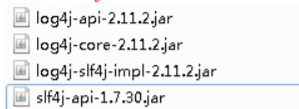Spring5框架新功能
整个Spring5框架的代码基于Java8,运行时兼容JDK9,许多不建议使用的类和方法在代码库中删除
Spring5.0框架自带了通用的日志封装
- Spring5已经移除Log4jCOnfigListener,官方建议使用Log4j2
Spring5框架整合Log4j2
第一步,引入jar包
<!--引入这个实现包,就可以到入其他的依赖--><!--log4j2--><!-- https://mvnrepository.com/artifact/org.apache.logging.log4j/log4j-slf4j-impl --><dependency><groupId>org.apache.logging.log4j</groupId><artifactId>log4j-slf4j-impl</artifactId><version>2.11.1</version><scope>test</scope></dependency>

- 第二步,创建log4j2.xml配置文件
<?xml version="1.0" encoding="UTF-8" ?> <!--日志级别以及优先级排序:OFF > FATAL > ERROR > WARE > INFO > DEBUG > TRACE > ALL--> <!--Configuration后面的status用于设置log4j2自身内部的信息输出,可以不设置,但设置成trace时,可以看到log4j2内部各种详细输出--> <configration status="INFO"> <!--先定义所有的appender--> <appenders> <!--输出日志信息到控制台--> <console name="Console" target="SYSTEM_OUT"> <!--控制日志输出的格式--> <PatternLayout pattern="%d{yyyy-MM-dd HH:mm.SSS} [%t] %-5level %logger[36] - %msg%n"/> </console> </appenders> <!--然后定义logger,只有定义了logger并引入appender,appender才会生效--> <!--root:用于制定项目的跟日志,如果没有单独指定Logger,则会使用root作为默认的日志输出--> <logers> <root level="info"> <appender-ref ref="Console" /> </root> </logers> </configration>
Spring5框架核心容器支持@Nullable 注解
- @Nullable注解可以使用在方法上面,属性上面,参数上面,表示方法可以为空,属性值可以为空,参数值可以为空
- 注解用在方法上面,方法返回值可以为空
- 注解使用在方法参数里面,方法的参数可以为空
- 注解使用在属性上面,属性值可以为空
Spring5核心容器支持函数式风格GenericApplicationContext
// 函数式风格
@org.junit.Test
public void testGenericApplicationContext() {
// 1. 创建GenericApplicationContext对象
GenericApplicationContext context = new GenericApplicationContext();
// 2. 调用context的方法对象注册
context.refresh();
context.registerBean("user1",User.class, ()-> new User());
// 3. 获取在Spring中注册的对象
User user = (User) context.getBean("user1");
System.out.println(user);
}
Spring5支持整合Junit5
整合Junit4
第一步,引入Spring相关针对测试依赖
<!--Spring单元测试框架--> <!-- https://mvnrepository.com/artifact/org.springframework/spring-test --> <dependency> <groupId>org.springframework</groupId> <artifactId>spring-test</artifactId> <version>5.2.8.RELEASE</version> <scope>test</scope> </dependency>第二步,创建测试类,使用注解的方式完成 ```java @RunWith(SpringJUnit4ClassRunner.class) // 加载单元测试框架 @ContextConfiguration(“classpath:bean1.xml”) // 加载配置文件 public class JTest4 {
@Autowired private UserService userService;
@Test public void test1() {
userService.accountMoney();}
}
<a name="440c1682"></a>
### Spring5整合Junti5
1. 第一步,引入Junit5的jar包
```java
<!--Junit5.3-->
<!-- https://mvnrepository.com/artifact/org.junit.jupiter/junit-jupiter-api -->
<dependency>
<groupId>org.junit.jupiter</groupId>
<artifactId>junit-jupiter-api</artifactId>
<version>5.3.2</version>
<scope>test</scope>
</dependency>
第二步,创建测试类,使用注解完成 ```java @ExtendWith(SpringExtension.class) @ContextConfiguration(“classpath:bean1.xml”) public class JTest5 {
@Autowired private UserService userService;
@Test public void test1() {
userService.accountMoney();}
}
3. 使用一个符合注解替代上面两个注解完成整合
```java
@SpringJUnitConfig(locations = "classpath:bean1.xml")
public class JTest5 {
@Autowired
private UserService userService;
@Test
public void test1() {
userService.accountMoney();
}
}
Spring框架新功能介绍(Webflux)
SpringWebflux介绍
- SpringWebflux是Spring5添加新的模块,用于web开发的,功能和SpringMVC类似的,Webflux使用当年前一种比较流程响应式编程出现的框架
- 使用传统web框架,比如SpringMVC ,这些基于Servlet容器,Webflux是一种异步非阻塞的框架,异步非阻塞的框架在Servlet3.1以后才支持,核心是基于Reactor的相关API实现的。
- 解释什么是异步非阻塞
- 异步和同步
- 非阻塞和阻塞
- 上面都是针对对象不一样
- 异步和同步针对调用者,调用者发送请求,如果等待对方回应之后才去做其他的事情就是同步,如果发送请求之后不等着对方回应就去做其他事情就是异步。
- 阻塞和非阻塞针对被调用者,被调用者收到请求之后,佐娃请求任务之后才会给出反馈就是阻塞,收到请求之后马上给出反馈然后再去做事情就是非阻塞
- Webflux特点
- 第一,非阻塞式,在有限资源下,提高系统吞吐量和伸缩性,以Reactor为基础实现响应式编程
- 第二,函数是编程:Spring5框架基于java8,Webflux使用Java8函数是编程方式实现路由请求
- 比较SpringMVC
- 第一,两个框架都可以使用注解,都晕习惯在tomcat等容器中
- 第二,SpringMVC采用命令式编程,Webflux采用异步响应式编程
响应式编程(java实现)
什么是响应式编程
响应式编程是一种面向数据流和变化传播的编程范式。这意味着可以在编程语言中很方便地表达静态或动态地数据流,而相关地计算模型会自动将变化地值通过数据流进行传播。电子表格程序就是一个响应式编程地一个例子。单元格可以包含字面值或者类似“=B1+C1”地公式,而包含公式地单元格的值会依据其他单元格的值的变化而变化。




